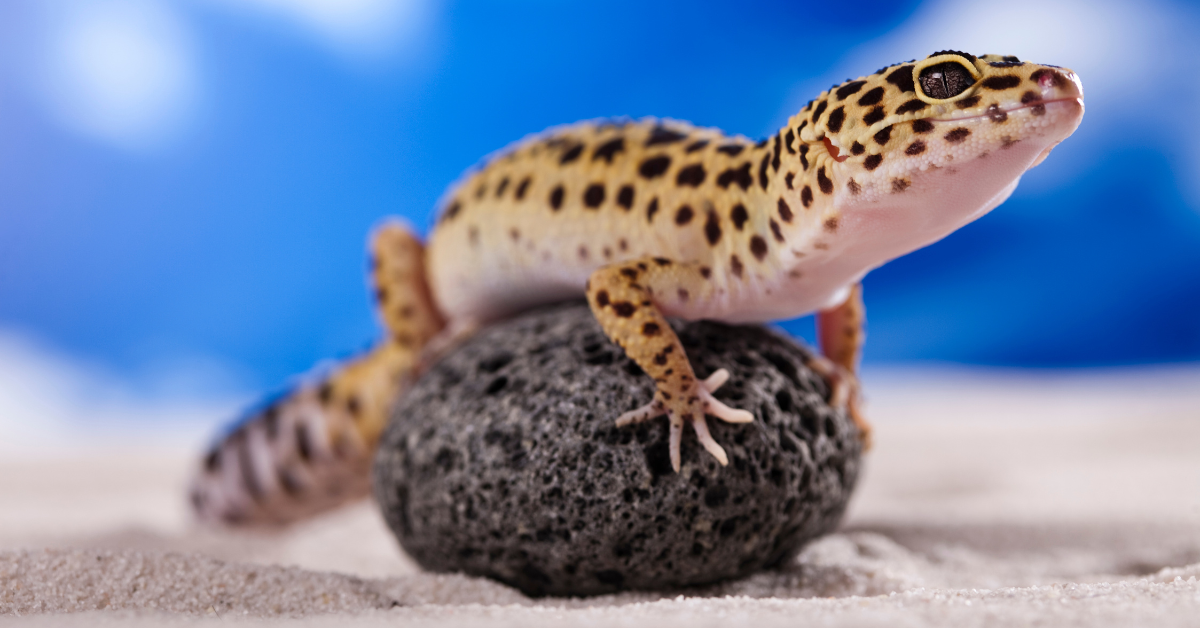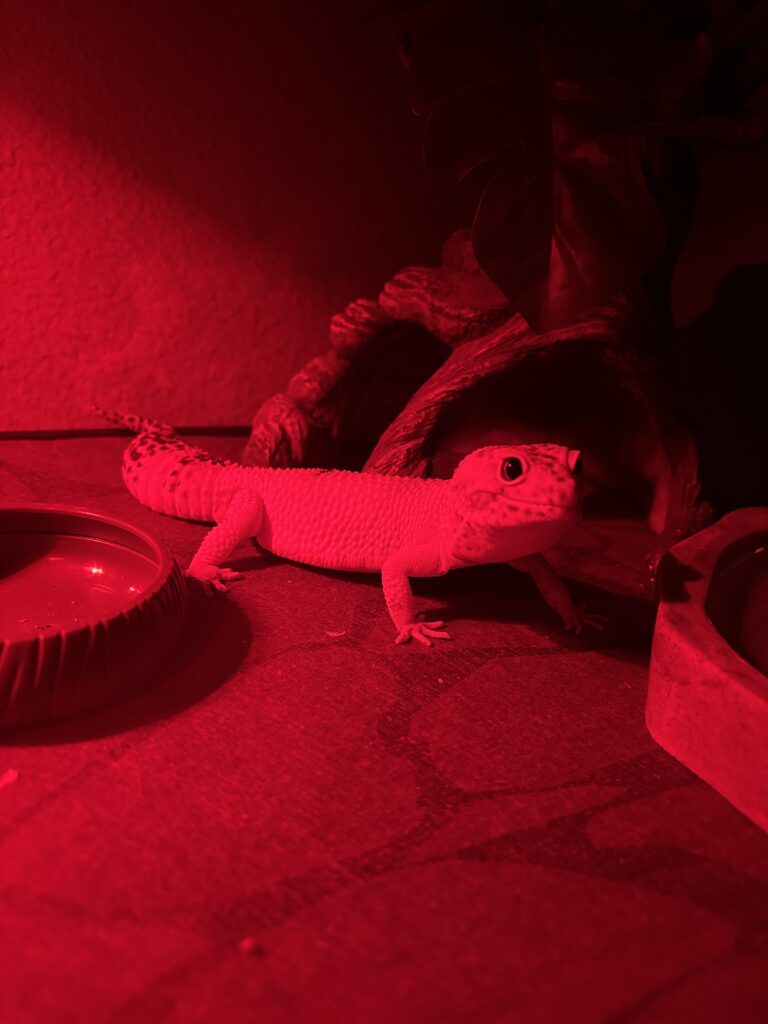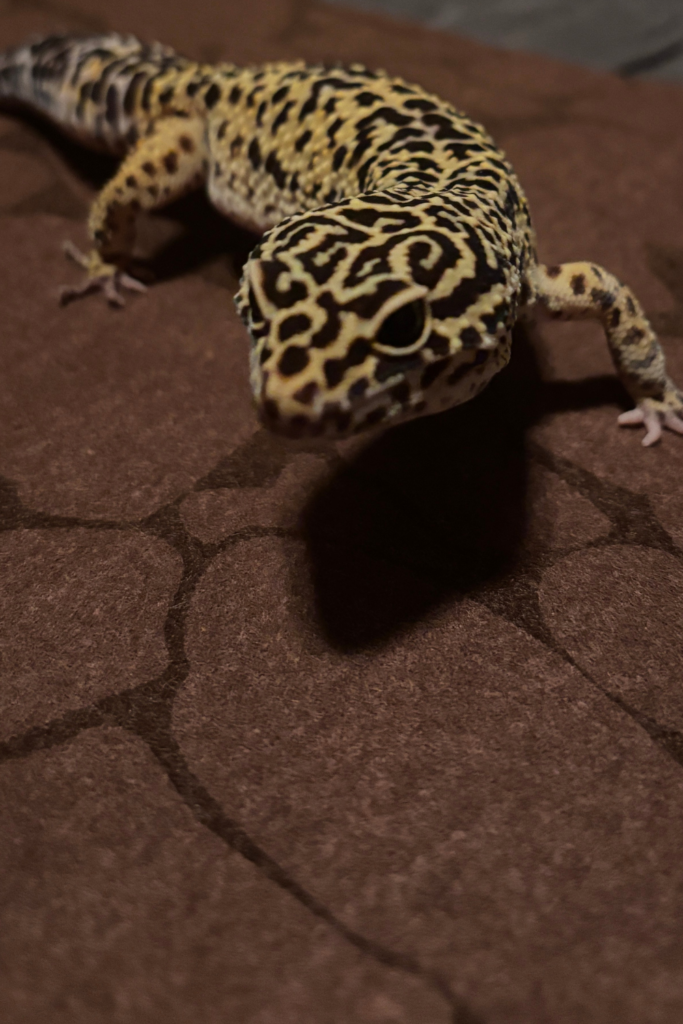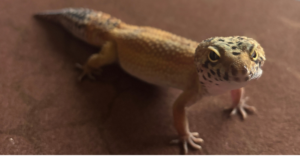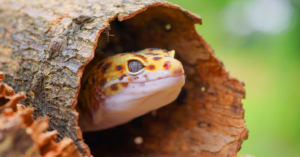
Key Takeaways for Leopard Gecko Care
- A healthy leopard gecko is active, alert, and maintains a plump tail.
- Proper habitat setup includes a 20-gallon tank, a safe substrate, and a thermal gradient for temperature regulation.
- Balanced nutrition requires gut-loaded feeder insects, calcium supplementation, and a consistent feeding schedule.
- Humidity control is essential for shedding, with a humid hide preventing retained skin and dehydration.
- Regular health monitoring helps catch early signs of illness, such as weight loss, lethargy, or abnormal shedding.
- Gentle handling and enrichment build trust, but geckos need time to adjust before frequent interaction.
- Routine cleaning and maintenance prevent bacterial buildup and ensure a stress-free environment.
- Avoiding harmful substrates like sand prevents impaction and digestive issues.
- Leopard geckos thrive in a stable, well-maintained environment that supports their natural behaviors.
- Consistent care and attention lead to a long, healthy, and rewarding relationship with your gecko.

Leopard Gecko Care: What Every Owner Needs to Know
The leopard gecko is a creature of the night—an expert hunter built for survival in the arid landscapes of South Asia.
Beneath the glow of the moon, it moves with precision, stalking crickets and roaches with the patience of a seasoned predator. In the wild, its life is a delicate balance of hunting, hiding, and avoiding larger threats. But in captivity, the game changes. No longer does it need to fend off dangers or search for food. Now, its survival depends on the environment and care you provide.
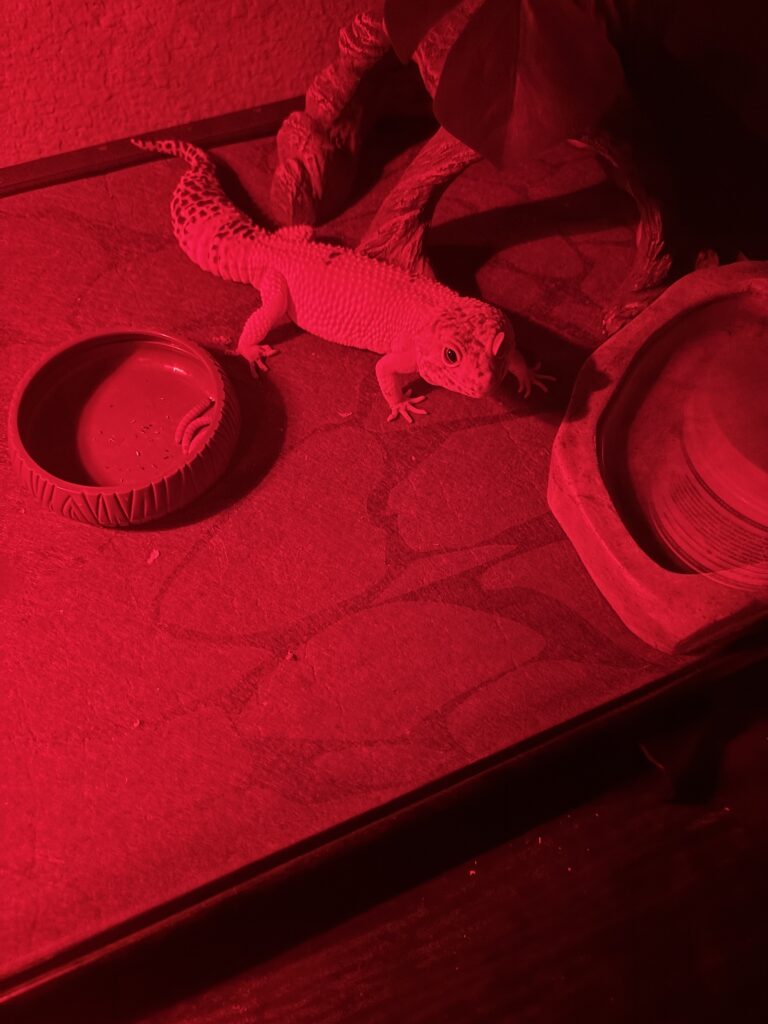
When a leopard gecko is given the right setup, diet, and handling, it thrives. It becomes confident, curious, and active, showing off its natural behaviors. But get it wrong? You’ll see stress, illness, and a gecko that hides in fear.
Caring for one of these incredible reptiles isn’t just about keeping it alive—it’s about understanding its instincts and creating a space where it can live its best life.
If you’re ready to raise a leopard gecko the right way, this article lays out everything you need to know.
Choosing the Right Leopard Gecko for Your Home
Bringing a leopard gecko into your home isn’t just about picking the one with the flashiest colors. This is a commitment—one that could last 20 years or more. So, before you take the plunge, you need to know what to look for. A healthy gecko is an active gecko, and spotting the right one is the first step to ensuring you don’t end up with a sick or stressed reptile.
Understanding Leopard Gecko Morphs and Age Considerations
In the wild, leopard geckos stick to the basics—yellow, brown, and black speckles that keep them camouflaged from predators. But in captivity, breeders have turned genetics into an art form. Some geckos glow in fiery tangerine, others are pale white with blood-red eyes. These variations, known as morphs, affect more than just appearance. Some morphs, like the Enigma, carry neurological issues, while others, like albinos, have light sensitivity.
Then there’s the age factor. Hatchlings might be tempting with their tiny size and youthful energy, but they require more delicate care. Juveniles, about two to seven months old, are a better starting point for new owners, already accustomed to feeding and handling. Adults, fully grown and often set in their behaviors, can be the best bet for those who want a predictable personality.
Where to Buy a Healthy Leopard Gecko
Not all sources are equal. A leopard gecko from a big-box pet store might be cheap, but at what cost? These geckos are often mass-produced, sometimes arriving at the store stressed, malnourished, or carrying parasites. If you want a gecko that’s been well cared for, go to a reputable breeder or reptile expo.
Here’s what to look for in a healthy gecko:
- Clear, bright eyes – No swelling, discharge, or cloudiness.
- A fat tail – This is their energy reserve. A thin tail is a red flag.
- Active and alert behavior – A healthy gecko should react to movement, not sit limp in your hand.
- Smooth skin – No stuck shed, open wounds, or sores.
- Regular breathing – No wheezing or excess mucus around the nostrils.
If a seller can’t provide a feeding history or seems reluctant to let you inspect the gecko up close, walk away. The right gecko is out there, and patience will pay off.
Setting Up the Ideal Habitat for Leopard Gecko Care
You wouldn’t expect a desert hunter to thrive in a damp jungle, and you certainly wouldn’t toss one into a barren glass box and call it home. The key to leopard gecko care is mimicking their natural environment—rocky, dry, and full of hiding spots. Get this right, and your gecko will be active, healthy, and stress-free. Get it wrong, and you’re setting the stage for illness, bad shedding, or worse.
Selecting the Right Enclosure
Think of your gecko’s enclosure as its personal hunting ground. Too small, and they’ll feel cramped. They are too big, and they might struggle to find food or feel exposed. A 20-gallon long tank is the sweet spot for an adult, giving them enough space to move while keeping everything within reach.
Material matters, too. Glass tanks are the standard, offering clear visibility and good airflow. Plastic tubs work in breeding setups but can lack proper ventilation. Front-opening enclosures? Even better—they make handling and cleaning a breeze. No matter what you choose, a secure lid is non-negotiable. Leopard geckos aren’t climbers, but if there’s a way out, they’ll find it.
Safe and Unsafe Substrates
What your gecko walks on is just as important as where they live. In the wild, they navigate rocky terrain, not loose sand dunes. Yet, one of the biggest mistakes owners make is using sand, thinking it’s “natural.” It’s not.
Here’s the hard truth: Loose substrate like sand can be deadly. Geckos tend to lick their environment, and swallowing sand can cause impaction—a life-threatening blockage in their digestive system. If you want to avoid a vet bill (or worse), stick to these safe options:
✅ Paper towels – Cheap, easy to replace, and great for hatchlings.
✅ Reptile carpet – Looks good but needs regular cleaning.
✅ Slate or ceramic tile – Retains heat well and is completely safe.
✅ Eco-friendly shelf liner – A solid, easy-to-clean alternative.
Avoid anything loose, like calcium sand, crushed walnut shells, or wood shavings—all of which can cause impaction or respiratory issues.
Heating, Lighting, and Temperature Regulation
Leopard geckos are ectothermic, meaning they rely on external heat sources to regulate their body temperature. In the wild, they bask on warm rocks at night, absorbing heat stored from the day. To recreate this, you’ll need to establish a thermal gradient in their enclosure.
Warm Side (88-90°F) – Where your gecko will digest food and warm up.
Cool Side (73-75°F) – A retreat when they need to cool down.
Basking Spot (95-100°F) – Optional but useful for extra heat absorption.
Best heat sources:
- Under-tank heaters (UTHs) – Simulate warm rocks, perfect for belly heat.
- Ceramic heat emitters (CHEs) – Provide heat without light, great for nighttime.
- Low-wattage heat bulbs – Work well in larger enclosures.
And the big question—does a leopard gecko need UVB lighting? The answer: it depends. While they’re nocturnal, studies show low-level UVB exposure can boost calcium absorption and overall health. A 2-7% UVB bulb, on for a few hours a day, is beneficial but not essential. If you skip UVB, be diligent with calcium supplements.

Humidity and Shedding Considerations
Desert animals still need moisture—just not too much. Keep humidity around 30-40%, or you’ll risk respiratory infections. The one exception? Shedding time.
Enter the humid hide, a must-have for any gecko setup. This is a small, enclosed space filled with damp sphagnum moss or paper towels, helping them shed cleanly. Without it, stuck shed can build up around their toes, eyes, and tail, leading to infections or lost digits.
Want to make one? Easy.
- Use a plastic container or commercial hide.
- Cut a doorway big enough for your gecko.
- Fill it with slightly damp (not soaking) moss.
- Place it on the warm side of the enclosure.
If your gecko has trouble shedding, a warm soak (not too deep!) or gentle removal with a damp cotton swab can help.
Essential Habitat Accessories
A bare tank is a boring tank. And a bored gecko? That’s a stressed gecko.
Your gecko needs at least three hides:
✅ Warm hide – Placed on the heated side for digestion.
✅ Cool hide – A retreat when it gets too hot.
✅ Humid hide – Helps with shedding and hydration.
Beyond hides, think about enrichment:
✅ Climbing structures – Rocks, branches, and cork bark to encourage exploration.
✅ Artificial plants – Adds cover and reduces stress.
✅ A stable water dish – Shallow, easy to clean, always available.
The more natural their environment, the more comfortable they’ll be. Keep it simple, keep it clean, and watch your gecko thrive.
Daily, Weekly, and Monthly Leopard Gecko Care Routines
Raising a leopard gecko isn’t just about setting up a perfect enclosure and calling it a day. These reptiles might be low-maintenance compared to some pets, but they still need regular attention. Think of it like maintaining a high-performance vehicle—ignore the basics, and things start to break down fast.
Consistency is key. A good care routine keeps your gecko healthy, stress-free, and thriving for years. But what exactly does that routine look like? Let’s break it down.
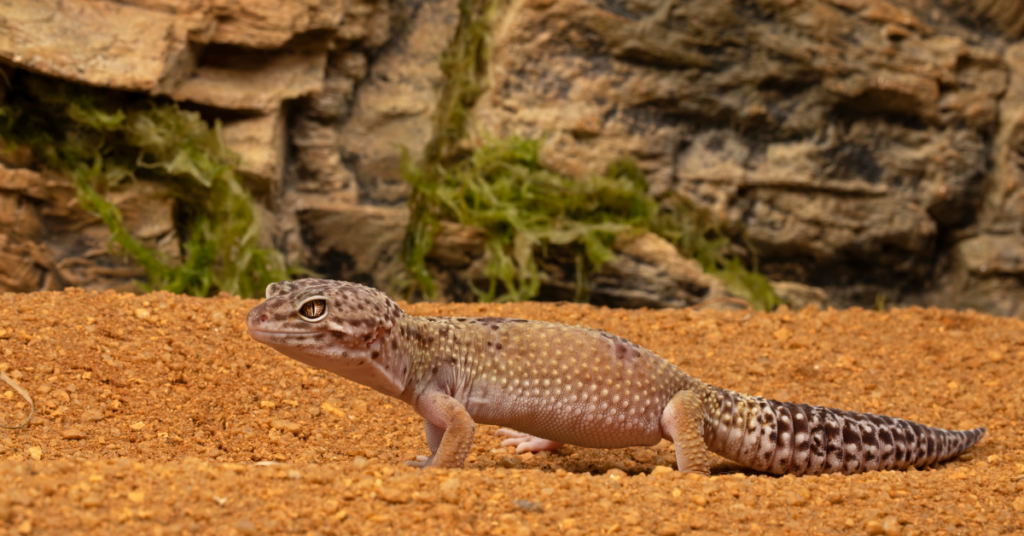
Daily Care Checklist
Every single day, your gecko relies on you to keep its environment safe and comfortable. A few quick checks in the morning and evening go a long way toward preventing health issues before they start.
✅ Monitor temperature and humidity – A thermal gradient isn’t just a nice addition; it’s essential for digestion and overall health. If your warm side isn’t hitting at least 88°F, your gecko’s body won’t function properly. Use a digital thermometer—don’t trust those cheap stick-on dials.
✅ Check the water dish – Clean, fresh water should always be available. It’s not just for drinking—geckos sometimes sit in it to cool down. A shallow, stable dish prevents spills and keeps the enclosure clean.
✅ Look for waste – Geckos are surprisingly tidy—they tend to poop in the same spot. Scoop out waste daily to prevent bacteria buildup and odor. If the droppings look off (too runny, too dry, or unusually colored), it could signal diet or health issues.
✅ Quick health inspection – Watch your gecko’s movements. Is it alert? Active? Breathing normally? Any stuck shed or visible injuries? Catching small problems early can save a lot of trouble later.
✅ Evening feeding (if applicable) – If it’s a feeding day, dust those insects with calcium and multivitamins before serving. Remove any uneaten insects after 15-20 minutes—roaming crickets can stress your gecko and even bite them.
Weekly Maintenance Tasks
Once a week, you’ll want to go beyond basic spot-checks and do a deeper clean. This keeps bacteria at bay and ensures your gecko’s environment stays in top shape.
✅ Refresh the humid hide – The damp moss inside your gecko’s humidity box can become a breeding ground for bacteria. Swap it out weekly to keep shedding smooth and prevent skin infections.
✅ Wipe down surfaces – Using a reptile-safe disinfectant, clean any surfaces that have come into contact with waste, food, or water spills. Don’t forget the inside of the water dish!
✅ Rotate enrichment items – Just like in the wild, a changing environment keeps geckos engaged. Move around climbing structures, hides, or artificial plants to encourage natural exploration.
✅ Check heating and lighting – If you’re using a UVB bulb, test it with a UV meter or replace it every 6-12 months, depending on the type. If using an under-tank heater, run your hand over the warm side of the enclosure to ensure consistent heat.
✅ Weigh your gecko (optional but recommended) – A drop in weight can signal illness or stress. Use a small kitchen scale and track their weight over time. A healthy adult should stay relatively stable, while juveniles will show consistent growth.
Monthly Deep Cleaning Routine
Every month, it’s time for a full reset. This might sound excessive, but trust me—keeping a clean enclosure is one of the easiest ways to prevent disease.
✅ Remove and disinfect all accessories – Hides, rocks, branches—everything should be scrubbed down with reptile-safe disinfectant and rinsed thoroughly.
✅ Replace the substrate (if applicable) – If you’re using reptile carpet, give it a deep clean or replace it entirely. Paper towels should be swapped out. Tiles can be wiped down with a disinfectant.
✅ Inspect the gecko closely – Look at their belly, feet, and tail. Any retained shed, unusual bumps, or sores? Now’s the time to catch any issues before they escalate.
✅ Evaluate their behavior – Is your gecko still active and curious? If it seems sluggish or refuses food for an extended period, consider a vet check-up.
✅ Check for hidden pests – Small mites or tiny gnats can sometimes sneak into enclosures. If you spot anything unusual, clean more frequently and ensure feeder insects aren’t bringing in unwanted hitchhikers.
Routine = A Healthy Gecko
Caring for a leopard gecko isn’t difficult, but it does require consistency. Stick to this routine, and you’ll have a pet that thrives instead of just survives. Skimp on it, and you’ll start seeing warning signs—bad sheds, sluggish movement, loss of appetite.
Wild geckos don’t get second chances. In captivity, their survival depends entirely on the quality of care they receive.
So, whether it’s a quick morning check or a full monthly deep clean, every step matters. Get it right, and your gecko will reward you with years of curious, alert, and active behavior.
Feeding Schedule, Food Options, and Supplementation
A leopard gecko is a born predator. In the wild, they wait patiently for movement—then strike with precision, swallowing their prey whole. In captivity, their diet needs to replicate that same level of nutrition and excitement. A poor feeding routine can lead to malnutrition, weak bones, and even deadly impaction. The key? A balanced diet, proper supplementation, and a schedule that meets their age and metabolic needs.
What to Feed for Optimal Leopard Gecko Care
Leopard geckos are insectivores—no fruits, no vegetables, just live prey. And not all insects are created equal. Some provide the protein and calcium they need, while others are more like junk food—okay as an occasional treat but dangerous in excess.
✅ Staple Feeder Insects:
- Crickets – High in protein, easy to digest, and stimulate natural hunting behavior.
- Dubia roaches – Nutrient-dense, slow-moving, and packed with essential minerals.
- Mealworms – These are convenient, but they should be part of a varied diet due to lower moisture content.
✅ Occasional Treats:
- Superworms are higher in fat and are best used sparingly.
- Waxworms – The reptile equivalent of fast food—delicious but fattening.
- Hornworms – Hydrating and packed with nutrients but expensive.
🚫 Avoid These Insects:
- Wild-caught bugs – Can carry pesticides and parasites.
- Fireflies and lightning bugs are highly toxic.
- Mealworms with hard shells – This can be difficult to digest for younger geckos.
Variety is key. Rotating different insects ensures your gecko gets a well-rounded diet while keeping mealtime exciting.
Feeding Schedule Based on Age
Leopard geckos have different dietary needs depending on their growth stage. Overfeeding or underfeeding can lead to obesity, weak bones, or stunted growth.
- Hatchlings (0-2 months) – Feed daily with small crickets or mealworms (4-8 per feeding).
- Juveniles (2-7 months) – Feed every other day, offering 6-10 appropriately sized insects.
- Adults (12+ months) – Feed every 2-3 days, with 8-10 insects per meal.
Portion size matters. A good rule of thumb is two appropriately sized insects per inch of body length. Always remove uneaten prey after 15-20 minutes to prevent stress and potential injuries from roaming insects.
Gut-Loading and Supplementing Feeder Insects
Even the best feeder insects are only as nutritious as what they eat. That’s why gut-loading is crucial—feeding your insects nutrient-rich foods before offering them to your gecko.
✅ Best Gut-Loading Foods:
- Dark leafy greens (collard, mustard, turnip greens)
- Carrots, squash, and sweet potatoes
- High-quality insect gut-load formulas
Dusting feeder insects with supplements is just as important. Calcium and vitamin D3 prevent metabolic bone disease, a painful and deadly condition caused by calcium deficiency.
✅ Supplement Schedule:
- Calcium with D3 – 2-3 times per week for juveniles, 1-2 times per week for adults.
- Multivitamins – Once a week for juveniles, once every two weeks for adults.
- Plain calcium (no D3) – Available at all times in a small dish inside the enclosure.
Using too much D3 can be as harmful as not using enough, so balance is key. If your gecko gets UVB lighting, they need less D3 supplementation because they produce their own.
Hydration and Water Needs
Leopard geckos don’t drink often, but water should always be available. A shallow, stable dish prevents spills and ensures they can hydrate when needed.
Dehydration is a serious issue, leading to bad sheds and digestive problems. If your gecko’s skin looks wrinkled or their eyes seem sunken, they may not be getting enough moisture. Misting the humid hide every few days helps maintain hydration, especially during shedding.
Feeding for a Thriving Gecko
Feeding isn’t just about survival—it’s about setting your gecko up for long-term health. A balanced diet, proper supplementation, and a feeding schedule that meets their age and metabolism ensure strong bones, a healthy weight, and an active, alert pet.
A well-fed gecko is a happy gecko. And when you get this right, you’ll see the results—smooth sheds, bright eyes, and a gecko that’s eager to hunt every time food hits the enclosure.
Monitoring Health: Signs of Illness and When to See a Vet
A leopard gecko might be small, but it’s a survivor. In the wild, these reptiles hide sickness for as long as possible—because in nature, weakness is a death sentence. In captivity, that same instinct makes it tough to spot when something’s wrong. By the time a gecko looks visibly ill, it could already be in serious trouble. That’s why proactive health monitoring is essential. Catch problems early, and you could save your gecko’s life.
Common Leopard Gecko Health Issues
Even with perfect husbandry, problems can still arise. Knowing what to look for—and what to do—can mean the difference between a simple fix and a costly vet visit.
✅ Metabolic Bone Disease (MBD)
- Caused by calcium deficiency or lack of vitamin D3.
- Symptoms: Soft jaw, bowed legs, trembling, or difficulty moving.
- Prevention: Proper supplementation and UVB exposure (if using).
✅ Impaction
- Happens when a gecko ingests undigestible material (like loose substrate).
- Symptoms: Bloated belly, lack of bowel movements, refusing food.
- Prevention: Use safe substrates and avoid overfeeding hard-shelled insects.
✅ Shedding Problems (Dysecdysis)
- Caused by low humidity or lack of a humid hide.
- Symptoms: Retained shed on toes, tail, or eyes.
- Fix: Provide a humid hide, soak affected areas in warm water, and gently remove stuck shed.
✅ Parasites
- Internal or external parasites can weaken your gecko over time.
- Symptoms: Rapid weight loss, runny stool, visible mites or ticks.
- Prevention: Quarantine new geckos, keep enclosures clean, and get fecal exams if needed.
✅ Respiratory Infections
- Caused by too much humidity or low temperatures.
- Symptoms: Wheezing, excess mucus, open-mouth breathing.
- Prevention: Keep humidity at 30-40% and maintain proper temperature gradients.
✅ Hypovitaminosis A
- Caused by lack of vitamin A in the diet.
- Symptoms: Swollen eyes, lethargy, trouble shedding.
- Fix: Supplement with multivitamins and feed gut-loaded insects rich in vitamin A.
Signs of a Healthy Leopard Gecko
A thriving gecko will:
- Have clear, bright eyes with no discharge.
- Maintain a plump, firm tail (this is their fat reserve).
- Shed cleanly without patches of stuck skin.
- Be active and alert, especially at night.
- Show a steady appetite and regular bowel movements.
If your gecko suddenly stops eating, moves less, or starts losing weight, something’s off. Behavioral changes are often the first warning signs of illness—don’t ignore them.
When to Take Your Gecko to a Vet
Not every issue requires immediate vet intervention, but some do. If you notice any of the following, it’s time to book an appointment:
🚨 Emergency Signs:
- Sudden weight loss (a plump tail shrinking fast is a red flag).
- Sunken eyes or wrinkled skin (signs of severe dehydration).
- Lethargy, unresponsiveness, or trouble moving.
- Open-mouth breathing, wheezing, or mucus buildup.
- No bowel movements for two weeks or signs of impaction.
- Severe stuck shed leading to loss of toes or tail damage.
A good reptile vet can mean the difference between life and death. Don’t wait until it’s too late—regular checkups can catch hidden issues before they become serious. If you’re bringing home a new gecko, an initial vet visit is a smart move to check for parasites or underlying health concerns.
The Key to a Long, Healthy Life
Leopard geckos can live 10 to 20 years in captivity, but only if they receive proper care. Keeping an eye on their weight, shedding, and activity level prevents small problems from turning into big ones.
A gecko that’s eating well, shedding cleanly, and staying active is a gecko that’s thriving. And when you stay observant and act fast when something seems off, you give your pet the best chance at a long, healthy life.
Handling and Enrichment for a Happy Leopard Gecko
Leopard geckos might not be cuddly, but that doesn’t mean they don’t recognize their owners. Over time, these reptiles learn to associate you with safety and food, making handling an enjoyable experience—if done correctly. But make no mistake: handling a gecko is an art, not a free-for-all. Move too fast, grab too roughly, or stress them out, and you could end up with a frightened gecko—or worse, a lost tail.
Beyond handling, enrichment plays a crucial role in their well-being. In the wild, they spend their nights hunting, exploring, and navigating rocky terrain. A boring, empty enclosure? That’s a recipe for stress. The goal is to provide mental and physical stimulation while respecting their natural instincts.
How to Properly Handle a Leopard Gecko
If you’re expecting your gecko to instantly trust you, think again. They’re prey animals, and your big, looming presence triggers deep survival instincts. You need patience, consistency, and the right technique.
✅ Step 1: Let Them Settle In
New gecko? Hands off for at least a week. They need time to adjust to their new environment before associating you with safety.
✅ Step 2: Start With Hand Presence
Place your hand inside the enclosure daily without touching them. Let them see and smell you, reinforcing that you’re not a threat.
✅ Step 3: Encourage Voluntary Climbing
Instead of grabbing, let your gecko walk onto your hand on their own terms. Slow, steady movements are key—jerky motions trigger their flight response.
✅ Step 4: Use Proper Handling Techniques
- Support their entire body—never dangle them by the tail.
- Keep movements smooth and predictable—no sudden grabs.
- Handle over a soft surface to prevent injury if they jump.
- Keep sessions short—start with 5 minutes and work up from there.
🚨 Biggest Mistake to Avoid: Tail Grabbing
Leopard geckos have autotomy, meaning they drop their tails when threatened. If startled or handled roughly, they’ll detach their tail as a defense mechanism. While it will grow back, the new tail is often shorter, stubbier, and never quite the same. Always handle them gently to prevent unnecessary stress or injury.
Providing Mental and Physical Stimulation
A gecko’s environment isn’t just a place to live—it’s a hunting ground, a hiding spot, and a puzzle to navigate. Without enough stimulation, boredom sets in, leading to stress, lethargy, and even reduced appetite.
✅ Rotating Enclosure Layout
Change up the placement of hides, rocks, and plants every few weeks. Small changes encourage natural exploration, keeping their instincts sharp.
✅ Introducing Climbing and Hiding Options
- Cork bark, logs, and flat rocks provide climbing opportunities.
- Artificial plants and foliage create visual barriers that reduce stress.
- Multiple hides prevent a single, overused spot from becoming dirty or stressful.
✅ Safe Free-Roaming Time
Once your gecko is comfortable with handling, let them explore a controlled, safe space outside the enclosure. Use a reptile playpen or a soft-surfaced area to let them stretch their legs.
✅ Hunting Games for Mental Stimulation
- Hand-feed with tongs to encourage interaction.
- Let them chase crickets or roaches instead of always using a feeding dish.
- Use different insect types to introduce variety and challenge.
Recognizing Stress and When to Stop Handling
Every gecko has its own personality—some tolerate handling well, while others prefer minimal contact. Know the signs of stress and respect their limits.
🚨 Signs of Stress During Handling:
- Rapid tail waving – A defensive warning.
- Vocalizing (chirping or squeaking) – Uncommon, but a sign of discomfort.
- Flattening the body – Trying to look bigger to scare you off.
- Sudden darting or jumping – Trying to escape.
- Refusal to eat after handling – They’re associating handling with stress.
If any of these behaviors appear, back off and try again another day. Over time, most geckos learn to tolerate, and even enjoy, handling. But forcing it? That’s a surefire way to break their trust.
The Key to a Confident, Engaged Gecko
Handling and enrichment are about building trust, reducing stress, and keeping their instincts sharp. A gecko that feels safe will be active, curious, and responsive. A gecko that’s over-handled or understimulated will be reclusive, jumpy, or prone to stress-related health issues.
With patience and the right approach, your gecko will not only tolerate handling—it may start coming to you willingly, climbing into your hand like a true desert explorer.
That wraps up handling and enrichment! Let me know if you want any adjustments before moving on to the final section—writing the introduction last.
Leopard Gecko Care: Key Takeaways for a Healthy Pet
A healthy leopard gecko is active, well-fed, and stress-free in a properly maintained environment.
Providing the right habitat, balanced nutrition, and consistent care ensures they thrive in captivity. Temperature regulation is crucial, as incorrect heating can lead to serious health issues. Regular feeding with gut-loaded insects and proper supplementation prevents metabolic disorders. Monitoring shedding, hydration, and behavior helps catch potential health problems before they become severe.
When leopard geckos feel safe, they display natural behaviors like exploring, hunting, and basking. Enrichment and handling help build trust, but forcing interaction too soon can create unnecessary stress. A stable routine, including cleaning and health checks, keeps them comfortable and healthy.
Owning a leopard gecko is about more than just providing food and shelter. It’s about replicating their natural environment in a way that supports their instincts and well-being.
By committing to proper leopard gecko care, you create a rewarding experience for both you and your gecko.
Affiliate Disclosure
This article contains affiliate links, including links from the Amazon Associates Program and other affiliate networks. If you purchase through these links, I may earn a small commission at no extra cost to you. These commissions help support the site and allow me to continue providing valuable content on leopard gecko care. I only recommend products that I believe are high quality and beneficial for pet owners.
